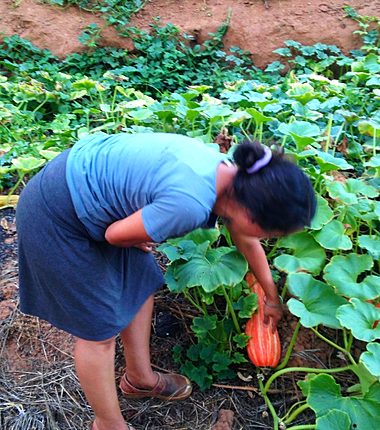
Fall in New Mexico is stunningly beautiful. The weather is crisp, but not too cold. And the sunshine takes on a golden quality like no other time of year. Bright blue skies outline the crowns of cottonwood trees, gently swaying in the autumn winds.
This Saturday was a perfect autumn day in New Mexico. I took a drive to the Sken:nen Ken'hak (Peace Forever) Educational Farm here in Espanola. It is operated by a friend of mine, Lorraine Kahneratokwas Gray, who is from the Mohawk tribe in New York. She and her partner, Emigdio Ballon (born in Bolivia), founded the Four Bridges Traveling
Permaculture Institute. http://4bridges.org These two wonderful people spend their lives teaching about sustainability. They have a farm here, where students come to learn about permaculture. And they travel around the world helping indigenous communities empower themselves with native and sustainable farming techniques, that heal the land and the people.

Lorraine Kahneratokwas Gray and Emigdio Ballon at Sken:nen Ken'hak
I met Lorraine a year ago, at the 7th Annual Traditional Agriculture and Sustainable Living Conference held in Espanola. The Four Bridges Traveling Permaculture Institute organizes this conference, which brings together tribal speakers from North and South America, along with international speakers who are doing phenomenal work in the realm of sustainability and healing the ecology. Last year's conference featured Paul Stamets, who has done extraordinary research showing how mushrooms and fungi in the soil act as an immune system for the earth. He has demonstrated how some mushrooms have the ability to clean up pollutants from the soil in a very short span of time. This year's conference featured noted activist Dr. Vandana Shiva, who has fought in India and around the world for farmer's rights to save and use their own traditional seeds.
When we read the news, there are so many stories about the powers that be, and how they wage war, or oppress people, or take a natural resource thousands of years in the making and exploit it to the breaking point. But the warriors of truth connected with the sustainability movement respect the sacredness of life. They know that health in the soil, and integrity in the food, creates the basis of health and integrity in the people. This is a very old wisdom, and one that I believe Guru Nanak deeply understood, as well.
 Last year, when I met Lorraine, she had some rare Hopi Pink corn seeds that she shared with me. When I first took the seeds, I had absolutely no experience growing corn. The seeds came to me at one of the most difficult times in my life. A time where everything that had seemed solid and secure disappeared overnight, and the future was completely unknown. When I first received these beautiful little seeds, colored a dark rich pink that opened the heart, it felt like a message from the Heavens. Don't give up hope. There is a future, even if you cannot see it. Focus on the seeds. Learn about them. Grow them. Nurture them. Let these seeds become your anchor.
Last year, when I met Lorraine, she had some rare Hopi Pink corn seeds that she shared with me. When I first took the seeds, I had absolutely no experience growing corn. The seeds came to me at one of the most difficult times in my life. A time where everything that had seemed solid and secure disappeared overnight, and the future was completely unknown. When I first received these beautiful little seeds, colored a dark rich pink that opened the heart, it felt like a message from the Heavens. Don't give up hope. There is a future, even if you cannot see it. Focus on the seeds. Learn about them. Grow them. Nurture them. Let these seeds become your anchor.
And that's what I did.
Month by month, I could not predict what work would come. I never knew exactly how the bills would get paid. But I put my focus on the seeds and researched how, exactly, to grow them. Hopi corn seeds are bred to survive in the desert. Traditional planting techniques to grow them are much different than the techniques used to grow water-heavy sweet corn. So I combed through the Internet, found experts who could give me advice, (thank you Rowen White from the Sierra Seed Cooperative http://sierraseeds.org), found a Shabad from the Siri Guru Granth Sahib that I could chant to the seeds, and imagined the possibilities. As soon as the worst of winter had passed, I took a shovel and started digging. Amending the soil. Figuring out the distance between plants. In April, I suffered through a health crisis. But still, on May 10th, which was the first new moon closest to the last frost date of the year, I took a little spade and planted that corn.
Within ten days, a few of the seeds started sprouting.
Throughout the summer, as the corn grew, I learned a lot of lessons. How incredibly tough that corn is. Surviving whipping hot summer winds. Temperatures spiking as high as 107 degrees F one day. But some evenings going down to almost 50 degrees. A hail storm left a lot of the leaves torn and ragged. Still, these plants grew. It was a profound testament to the tenacity of life. To how life will fight for its own survival, against the intense challenges of nature. Even though I had maybe 30 viable plants, which is very low in terms of corn being able to pollinate; and even though I learned the hard way about the pests that like corn; still, in the end, there were a few honest to goodness corn cobs that grew. And one corn cob that was completely pollinated and perfectly formed. When I picked it in September, the seeds were mostly white with only a hint of pink here and there. But that plant had given me 185 good healthy seeds to use next year.
This is the basis of prosperity. Of life. You start with seeds. You do your best. You work in a symbiotic relationship with the plants and with nature. And then Mother Earth gives back more than what you started with. This is how the Creator has fashioned the Creation.
On Saturday, I brought some of those seeds to Lorraine. Gave back to the woman whose seeds had started the process. Last year, she was someone I had just met. This year, she was someone who I felt a warm connection to. We had stayed in touch here and there for the last 12 months. I had gone back to the conference she organized again this year. When I brought the seeds to her, we sat outside, under the delicious autumn sky and just talked. Talked about the land, about the conference, and about plans for the future. Sharing stories. Sharing seeds. Enjoying the grace of the last year. Expressing hopes for the year to come.
The cycle of life.
When I meditate on Gurbani, the phrase "Har Naam" often appears. The translation most used in English is, "the Lord's Name." But there is a whole world that gets lost in that translation. "Har" also refers to the seed. The Divine Seed. The Divine Essence. Every single human being has the seed of Divinity within its body. And under the right conditions, with the proper cultivation, that seed can sprout and come to life. We can live in the awareness of our Divinity. Our identity, our Naam, can become an expression of that Har, that Divine Seed.
The Hopi corn showed me this year just how real it all is. Life comes from the seed, then goes back to the earth, who multiplies it. The seed of the human is Divine Consciousness. If we grow it, it, too, will multiply.
A year after the corn seeds came into my life, my future is more stable than before. Steady work has come back. Ironically, the work that I am now doing (for SikhNet) began to appear at about the same time the corn started to sprout. When I think about it, about how the corn grew and work grew at the same time, I do not think this is a coincidence. But neither do I have the words to explain what the connection is. All I know is that the hope those seeds gave me last year have been fulfilled in ways I could not have imagined. Despite all of the challenges, the cycle of life goes on.
Before I end, I have one more seed story to share. Rowen White, who helped me when I was researching the Hopi Pink Corn, is one of the speakers at the Traditional Agriculture conference held in Espanola. This year, she shared some very special squash seeds with me. A few years ago, a farmer in Minnesota was tilling his land when he hit upon a Native American archeological site. The elders from the local Anishinaabe tribe were called to investigate, and one of the things they found was a clay ball that rattled when they shook it. When the tribes people opened the clay ball, they found seeds inside. They took the seeds to be carbon dated, and discovered that the seeds were over 800 years old. The tribes people planted the seeds, which still had viable DNA. Those seeds produced a squash which no one has seen or has a record of. It is more narrow than round, orangish in color and BIG. Winona LaDuke named it Gete-okosomin which means "really cool old squash." Rowen has been growing these plants at her farm. She shared some of her seeds with me. I feel very privileged that these seeds have come to me so early in the cycle of their rebirth.
Rowen White and the Geteokosoman (really cool old squash)
Of course, I have never grown squash before. And we will have to see how these plants do in the summer winds of New Mexico.
But next year, I pray that I will have more seeds to pass on, and another story to tell.
With Divine Light, Ek Ong Kaar Kaur







